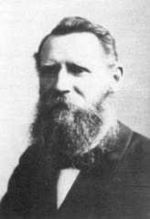Woldemar Voigt facts for kids
Quick facts for kids
Woldemar Voigt
|
|
|---|---|

Woldemar Voigt (1850–1919)
|
|
| Born | 2 September 1850 |
| Died | 13 December 1919 (aged 69) |
| Nationality | German |
| Alma mater | University of Königsberg |
| Known for |
|
| Awards | ForMemRS (1913) |
| Scientific career | |
| Fields | Physicist |
| Institutions | University of Göttingen |
| Doctoral advisor | Franz Ernst Neumann |
| Doctoral students | Paul Drude |
Woldemar Voigt (born September 2, 1850 – died December 13, 1919) was an important German physicist. He taught at the Georg August University of Göttingen. Voigt led the Mathematical Physics Department there. Later, other famous physicists like Peter Debye and Max Born took over his role.
Contents
About Woldemar Voigt
Woldemar Voigt was born in Leipzig, Germany, and passed away in Göttingen. He was a student of Franz Ernst Neumann, another well-known scientist.
Voigt's Scientific Work
Voigt spent his time studying different areas of physics. He focused on:
- Crystal physics: This is the study of how crystals behave.
- Thermodynamics: This field deals with heat and how it relates to other forms of energy.
- Electro-optics: This looks at how light and electricity interact.
His most important book was Lehrbuch der Kristallphysik, which means "Textbook on Crystal Physics." It was first published in 1910.
Key Discoveries and Concepts
Voigt made several important contributions to science:
- Voigt effect: He discovered this effect in 1898. It describes how light behaves when it passes through certain materials in a magnetic field.
- Tensor: He introduced the word "tensor" in its modern scientific meaning in 1898. Tensors are mathematical tools used to describe physical properties that have both size and direction, like stress or strain in materials.
- Voigt profile: This is a special curve used in physics to describe how light is absorbed or emitted by atoms.
- Voigt notation: This is a simpler way to write down complex mathematical equations used in crystal physics.
Voigt was also a talented amateur musician. He was known for his knowledge of the music of Johann Sebastian Bach.
The Voigt Transformation
In 1887, Voigt came up with a set of equations known as the Voigt transformation. These equations described how measurements of space and time might change when you move from one place to another at a very high speed.
Understanding Transformations
Imagine you are on a train moving very fast. If you drop a ball, it falls straight down from your point of view. But to someone standing still outside the train, the ball would appear to move forward as it falls. A "transformation" is a mathematical way to connect what one person sees to what another person sees, especially when they are moving relative to each other.
Voigt's transformation was an early step towards understanding how space and time are connected, especially for things moving close to the speed of light.
Voigt's Work and Later Discoveries
Voigt's equations were similar to the later and more famous Lorentz transformation, which is a key part of Albert Einstein's relativity theory.
- Hermann Minkowski (1908) and Hendrik Lorentz (1909) both recognized the importance of Voigt's early work. Lorentz even said he wished he had known about Voigt's equations earlier!
- Voigt's transformation showed that time could seem to slow down for moving objects, a concept called time dilation. However, the amount of time dilation in Voigt's equations was slightly different from what we now know to be correct.
Experiments and the Speed of Light
Voigt's transformation correctly showed that the speed of light would appear the same to observers moving at different speeds. This matched experiments like the Michelson–Morley experiment. However, later experiments, especially the Ives–Stilwell experiment in 1938, helped scientists figure out the exact way time dilation works. These experiments showed that the Lorentz transformation was more accurate than Voigt's for describing how time changes for moving objects.
See also
 In Spanish: Woldemar Voigt para niños
In Spanish: Woldemar Voigt para niños
- Dyakonov–Voigt wave
- Stark effect
- German inventors and discoverers

